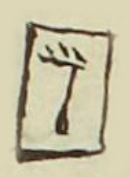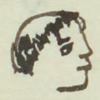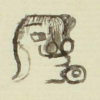Cuaochpa (MH745v)
This black-line drawing of the compound glyph for the ethnicity, Cuaochpa, attested here as pertaining to a man, shows a vertical rectangle with a footprint inside. The rectangle may be a cuachtli (cape or cloak), used here as a phonetic indicator for the start of the name. The footprint inside the rectangle also appears to be a phonetic indicator for the -pa (toward) part of the name, or a short version of -pan or paina (see below). The footprint might also point to the -o- by suggesting a road (otli).
Stephanie Wood
Footprint glyphs have a wide range of translations. In this collection, so far, we can attest to yauh, xo, pano, -pan, paina, temo, nemi, quetza, otli, iyaquic hualiloti, huallauh, tetepotztoca, totoco, -tihui, and the vowel "o." Other research (Herrera et al, 2005, 64) points to additional terms, including: choloa, tlaloa, totoyoa, eco, aci, quiza, maxalihui, centlacxitl, and xocpalli.
Stephanie Wood
1560
Jeff Haskett-Wood
icximachiyotl, xocpalli, icxipamitl, huellas, textiles, telas, etnicidades, Michoacán, nombres de hombres

Cuaochpa, an ethnic group, people from Michoacan, https://nahuatl.wired-humanities.org/content/cuaochpa
cuach(tli), a large cape or cloak, https://nahuatl.wired-humanities.org/content/cuachtli
o(tli), road, https://nahuatl.wired-humanities.org/content/otli
Gente de Michoacán
Stephanie Wood
Matrícula de Huexotzinco, folio 745v, World Digital Library, https://www.loc.gov/resource/gdcwdl.wdl_15282/?sp=569&st=image
This manuscript is hosted by the Library of Congress and the World Digital Library; used here with the Creative Commons, “Attribution-NonCommercial-ShareAlike 3.0 License” (CC-BY-NC-SAq 3.0).











